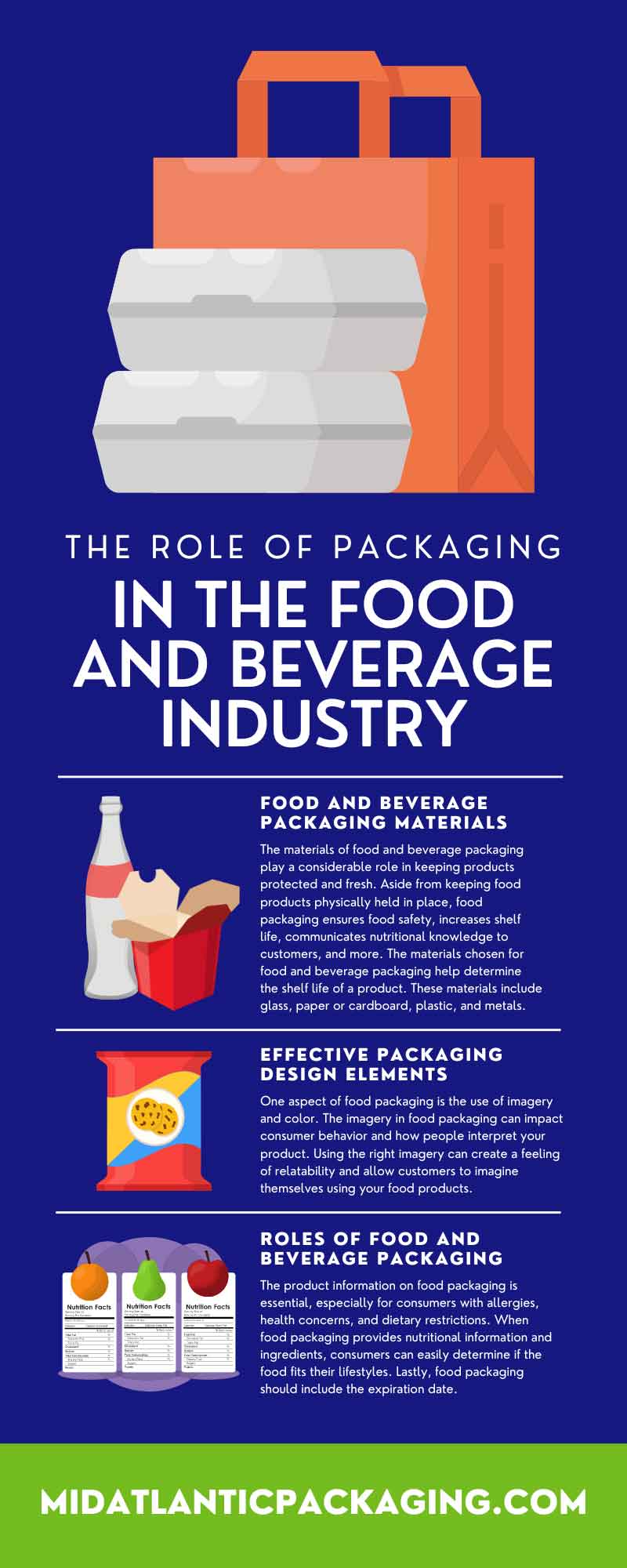The Role of Packaging in the Food and Beverage Industry
Posted by Julie Rotuno on 16th Jun 2023
Food and beverage companies don’t just use word of mouth to get their products out the door; they also incorporate product packaging. Here’s how product packaging has a role in the food and beverage industry.
Packaging in Food and Beverage Marketing
Food packaging protects products from contamination and damage and serves as a conduit for consumer marketing. Product packaging helps create a defined brand identity and grabs consumers’ attention when incorporating the right elements. As such, product packaging can easily make products stand out on store shelves and convey their message in seconds, easily attracting consumers’ attention.
Proper product packaging can influence a consumer’s emotional response, ranging from creating feelings of nostalgia and excitement to therapeutic tranquility. Emotional connections through product packaging can create brand loyalty and generate repeat customers.
Food and Beverage Packaging Materials
The materials of food and beverage packaging play a considerable role in keeping products protected and fresh. Aside from keeping food products physically held in place, food packaging ensures food safety, increases shelf life, communicates nutritional knowledge to customers, and more. The materials chosen for food and beverage packaging help determine the shelf life of a product. These materials include glass, paper or cardboard, plastic, and metals.
Glass has significantly contributed to food and beverage preservation for thousands of years. People as far back as the ancient Egyptians used glass containers to hold oils and ointments. In the modern era, glass has several advantages, including being chemically inert and odorless.. Paper packaging products, such as sulfite, kraft, and parchment paper, benefit from recycled materials and work for various packaging applications. Lastly, metal and plastic provide a durable, long-lasting means for food product transportation and preservation.
Effective Packaging Design Elements
Packaging design elements include typography, color, structure, and imagery to capture customers’ attention and communicate product values. As such, understanding the use of packaging designs allows food and beverage products to resonate with customers and helps them stand out from the competition.
Imagery and Color
One aspect of food packaging is the use of imagery and color. The imagery in food packaging can impact consumer behavior and how people interpret your product. Using the right imagery can create a feeling of relatability and allow customers to imagine themselves using your food products.
Furthermore, color can create an emotional response in customers. It’s a powerful tool in food packaging design, as it makes brand recognition and can help itself stand out from the competition. For instance, green can convey high-energy and serotonin-inducing emotions, while green relates to natural, healthy foods to create a sense of calm. Incorporating the right colors in food packaging can hit all the cues a customer seeks.
Structure and Typography
The structure and typography of product packaging are practical aspects of creating an impactful product. Firstly, typography can make a product stand out against other food products along store shelves, helping to communicate brand messaging and values. Whimsical, playful fonts can work for exciting, children-focused snacks, while more elegant, sophisticated fonts can work for organic or high-class foods.
Packaging structures can range from simple designs, such as bottles or cans, to more complex designs, like window boxes and luxury bakery boxes. Packaging structure design can help food products separate from the competition while capturing brand identity, driving consumer behavior, and communicating values.
Roles of Food and Beverage Packaging
Packaging has various beneficial roles in the food and beverage industry, including product information display, food freshness, preventing product contamination, and more. Ensuring that food and beverage products make it through transit from store shelves to customers’ homes is essential.
Displays Important Information
When a customer looks at food packaging, they look for specific information to ensure it’s right. Product packaging ensures customer safety by decreasing exposure to moisture and contaminants while displaying essential health and safety information. CDC rules state that all food product packages must display a list of ingredients in their products and nutritional facts.
The product information on food packaging is essential, especially for consumers with allergies, health concerns, and dietary restrictions. When food packaging provides nutritional information and ingredients, consumers can easily determine if the food fits their lifestyles. Lastly, food packaging should include the expiration date.
Prevents Product Damage and Contamination
If there’s one thing proper food packaging can do, it is to protect food and beverage products from contamination and damage. It’s integral to preventing physical damage and sealing food products from contaminants, especially during handling, warehousing, and shipping. Food packaging, such as plastic wrapping, bubble wrap, cardboard boxes, and corrugated boxes can protect food products from physical damage that results from traumas and shocks.
Food products must remain protected from contaminants to prevent customers from getting illnesses. Consequently, packaging durability is essential for preventing harm during transit or in instances of rough handling. Furthermore, durable packaging should protect products from cross-contamination and moisture, as those can result in spoiled food.
Improves Product Shelf Life
Another crucial factor of food and beverage packaging is its ability to increase shelf life considerably. Low-quality, faulty packaging can result in shorter product shelf life, thus resulting in potential health problems. While many consumers assume lower temperatures can preserve food products for longer, that’s only partially correct.
The inside of the food packaging can result in decomposition if constantly exposed to oxygen. So having the right product containers can prevent exposure to oxygen and keep food fresh longer. Having protective, high-quality packaging is essential to the food and beverage industry.
Maintains Food Freshness
One reason food and beverage packaging matters is that it maintains food freshness. Freshness and food product quality are significantly easier to preserve with the right packaging. As such, packaging technology allows food manufacturers and processors to supply fresh, untarnished food products to customers.
Modern food packaging technology improves food preservation and sets quality standards for customer expectations, especially for international food companies and manufacturers. Customers won’t have to fear their food becoming spoiled or outdated with the proper packaging, no matter where it originates from.
Food and beverage packaging should come from a reliable company that understands the importance of product preservation and protection. Mid-Atlantic Packaging provides small businesses with high-quality bags, boxes, packaging, and shipping products. Our custom plastic bags for businesses help small establishments make their mark in a highly competitive market. They also provide practical brand display opportunities, help spread the word about your business, and bring in repeat customers. If you want to know more about our plastic bags and various custom packaging products, contact us today.




